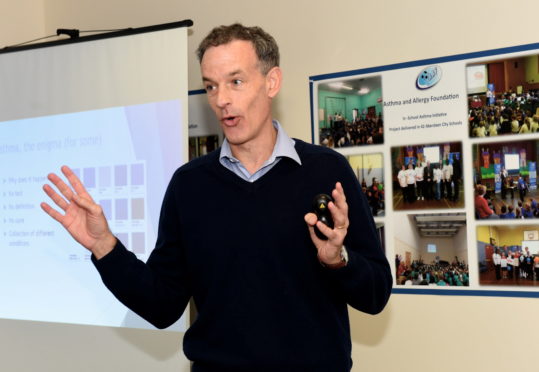A landmark discovery by north-east researchers has linked air pollution with harm to babies during pregnancy.
Scientists at Aberdeen University have found that infants’ growth can be stunted if they are exposed to nitrogen dioxide while in the womb.
And in turn, this can lead to a higher chance of them developing heart disease, asthma and diabetes.
Nitrogen dioxide is primarily generated by vehicle traffic but can also come from cigarette smoke and kerosene heaters and the researchers are calling for “urgent” measures to minimise pregnant mothers’ exposure to the gas.
The group studied more than a decade’s worth of research evidence from around the globe to come to their conclusion, finding that fetal growth was particularly affected by pollution in the final three months of pregnancy.
Professor Steve Turner, who led the investigation, said: “In our research we looked at all the studies that measured the effects of mothers’ exposures to everyday substances including air pollutants, alcohol, and diet on the size of the unborn baby, measured through ultrasound from halfway through the pregnancy and onwards.
“The seven studies where air pollution was measured and linked to fetal size were from different geographical areas of the world, including Australia, the USA and several countries in Europe.
“However in all of the studies the evidence was clear that, in the third trimester in particular, exposure to nitrogen dioxide reduced fetal growth.”
Some of Scotland’s streets are regularly shamed for having high levels of air pollution.
In January, Friends of the Earth Scotland revealed that streets in Glasgow, Edinburgh, Dundee and Aberdeen had all either breached the legal limits or come “perilously close” to doing so.
Prof Turner added: “Our research has shown that the link between exposure and fetal growth is apparent well before birth, so any potential interventions need to happen in the early stages of pregnancy.
“Furthermore, the findings also suggest that public health measures are urgently required to minimise pregnant mothers’ exposures to nitrogen dioxide.”
Time to act
Environmental campaigners say councils and the Scottish Government need to act soon to reduce air pollution and its associated health risks.
Friends of the Earth has called for the widespread introduction of park and ride networks and low emission zones (LEZ) in city centres.
LEZs ban traffic which do not meet emission standards by using number plate recognition cameras to send fines to the vehicles’ owners.
They have been set up in Greenwich, Oxford and London and the first in Scotland came into effect in Glasgow in December.
Councils in Aberdeen, Dundee and Edinburgh are currently carrying out assessments for how LEZs could be established in their cities.
Friends of the Earth Aberdeen co-ordinator Gregor McAbery said: “Almost every week now we see new research confirming the direct impact of air pollution, largely from diesel vehicles on our roads.
“Air pollution from traffic is a public health crisis, affecting us before we are even born, and shortening the lifespans of many adults who work in or live in or even visit busy traffic corridors.”
“We also need to ensure the public is kept informed so that they know why changes are coming for the sake of their health, what they should think of when buying a vehicle, and why walking, cycling and using public transport are good for them and others.”










